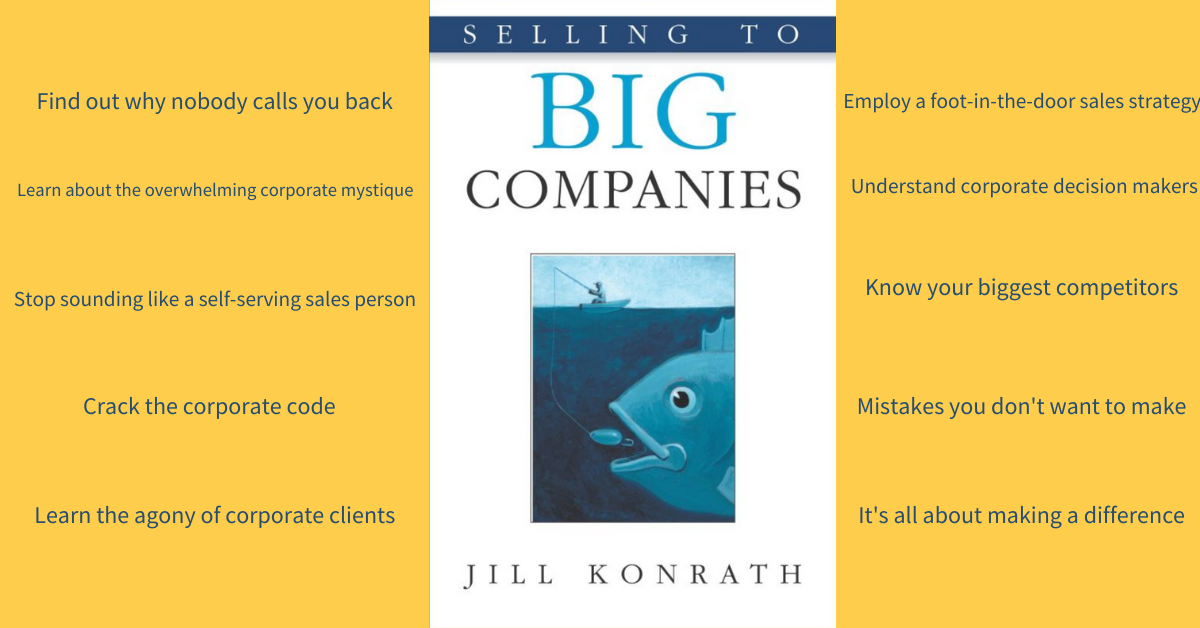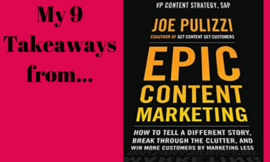Selling to Big Companies by Jill Konrath is a book that will teach you what its title says. Jill Konrath is a speaker, author and thought leader in the sales strategies space. She’s also written four books all about helping entrepreneurs win at B2B sales. In fact, if you visit her site, it’s packed with FREE resources to help you succeed in your business. But I want to point something out to those of you who are not entrepreneurs, but work in sales. If you want to keep hitting it out of the park, keep learning. Never stop. You should also check those resources out and read the book.
When I started my business, I knew I wanted to work with big companies. I created a list of companies, and just started calling them. By the time I found out about Jill’s book, I had already landed big company clients. So what prompted me to read it? It was that Jill took something I had done (learned to sell to big companies), and blueprinted it in a book. I wanted to learn her tactics, and find out if there was a better, more efficient way to do it.
In this post, I share some of the things I learned, from Jill Konrath’s book, Selling to Big Companies, which I recommend to both entrepreneurs and sales people looking to work with large corporations.
1. “Successful selling comes from a solid, in-depth understanding of your customers.”
Setting up meetings with prospective clients does take time. This means taking the time to learn about their perspective – how they view their problem and their solution.
This demands work and persistence. But there are plenty of rewards on the other side.
2. “The easiest and fastest way to get into a big company is through one of its functional areas.”
Let’s get a couple of things straight. “Easiest” doesn’t mean that it won’t take work, and “fastest” doesn’t mean that it won’t take time.
So if you mean business, here’s what you need to do:
- Find out the name of the decision maker – that is the person who is in charge of saying yes to your offer
- Understand the assets and liabilities about working with the company – but don’t let this overwhelm you
- Understand the company’s operations and figure out why they really need your service (think – what is missing in their process)
- Determine how what you offer will make a difference to their results (think – what will their outcome be if they work with you)
- Create a strategy that will help them say yes
3. “Every time you talk with them, you must make reference to something that indicates your knowledge of their specific business, industry, challenges, or operation.”
Do your research. Understand their business so well that you can offer your insight into their operation or process. Show them that your knowledgeable – about them and their needs.
The best way I know how to do this, is to offer them insights that they don’t know, or didn’t think about. This why it’s so important to never ever stop reading and learning, and staying current.
4. “Keep your eyes open for emerging needs, other problems requiring resolution, and gaps between your client’s desired future and today’s reality.”
Once you do begin working with big companies, don’t become content with whatever it is you’re offering. Find other ways to help them, and keep ahead by offering fresh offers and advice.
Here’s what I can tell you about that. You can cheat by being a really good listener. Many times, your client will actually tell you the direction in which they are going. It’s up to you to think about more ideas of how you can help them succeed. Figure out what your part is in your customer’s journey to success – not your success, their success. You succeed when your client succeeds. If you constantly bear this in mind, you will always be finding new ways to help them, and you’ll become a go-to resource for them.
5. “Targeting: It’s not a number’s game”
Find a niche. Yes, this sounds counterintuitive. But, by finding a niche you’ll be able to increase both your sales and your profits. When you target specific businesses based on their industry, their process, or even the types of products they sell, and when you make it known to them that you only work with certain companies, you increase the likelihood that they will want to work with you.
Sure, you can go after everyone. But that just dilutes your energy and the chances of closing a business deal. Once you choose a niche, and invest your time marketing to a specific segment of companies, your chances of success rise exponentially.
6. “Powerful value propositions open doors – quickly!”
Understand what you’re offering, and what is so unique about it that companies need to work with you – and only you. Get into specifics, give your prospects hard data, facts and figures. If you can’t offer hard data, it’s especially important to help prospects understand what your offering will do for them.
Jill brings a bunch of examples of well-written propositions which can help you write your own.
Don’t know what your value proposition is? It’s time to speak to your clients. There’s a lot of great information in the book on how to do this.
7. “Look for words that describe their problems and their opportunities.”
When you prepare your approach in your phone calls and emails, you want to use their language. When you use words and phrases your prospects use, you make them feel you understand their business.
Not sure how to find out what language they use? Jill tells you. Check out their website, annual report, and media center for starters. If you want more ideas, read the book.
8. “Create opportunities with strategic alliances”
Jill says that strategic alliances are her “most powerful networking strategy.” This means creating partnerships with other businesses that offer their services to the company you want to do business with. Figure out how to leverage your combined talents to help your mutual clients achieve their objectives, while meeting your own.
9. “Follow up on the connections”
You’re not going to get a yes the first time you reach out, so follow up is critical.
If somebody referred you to your contact person, make sure to make a mention of it. And make sure that in your phone conversation you pique their interest, even if you leave a voice mail.
My personal experience with following up, has been to be clear on the follow up during the initial conversation. Ask them if you can be in touch in a month, three months, or even six months. Then put it in your calendar, with an alarm notification, so you actually remember to call them. I have found that doing this shows your prospect that you’re serious. And by doing it again, and again, you’ll be building a relationship and trust.
10. “Your entire approach needs to be pressure-free and focused on making a difference.”
I love this tip because it’s so customer-centric. Selling to your customers should never ever be about you. Sure you want to improve sales, grow the business, get your bonus, whatever. But your customer doesn’t care about what you need, nor will your needs help you close the sale. Keep everything you say focused on your prospective customer’s needs. That’s a great tip – not just for working with big companies, but working with anyone.
Want to learn more about how you can sell to big companies?
Read the book. It’s really all in there.


